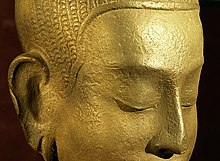
In Jainism, meditation has been a core spiritual practice, one that Jains believe people have undertaken since the teaching of the Tirthankara, Rishabha. All the twenty-four Tirthankaras practiced deep meditation and attained enlightenment. They are all shown in meditative postures in the images or idols. Mahavira practiced deep meditation for twelve years and attained enlightenment. The Acaranga Sutra dating to 500 BC, addresses the meditation system of Jainism in detail. Acharya Bhadrabahu of the 4th century BC practiced deep Mahaprana meditation for 12 years. Kundakunda of 1st century BCE, opened new dimensions of meditation in Jain tradition through his books Samayasāra, Pravachansar and others.
Jain meditation and spiritual practices system were referred to as salvation-path. It has three important parts called the Ratnatraya "Three Jewels": right perception and faith, right knowledge and right conduct. Meditation in Jainism aims at realizing the self, attaining salvation, take the soul to complete freedom.
It aims to reach and to remain in the pure state of soul which is
believed to be pure consciousness, beyond any attachment or aversion.
The practitioner strives to be just a knower-seer (Gyata-Drashta). Jain
meditation can be broadly categorized to Dharmya Dhyana and Shukla Dhyana.
There exists a number of meditation techniques such as pindāstha-dhyāna, padāstha-dhyāna, rūpāstha-dhyāna, rūpātita-dhyāna, savīrya-dhyāna, etc. In padāstha dhyāna one focuses on Mantra. A Mantra could be either a combination of core letters or words on deity or themes. There is a rich tradition of Mantra in Jainism. All Jain followers irrespective of their sect, whether Digambara or Svetambara,
practice mantra. Mantra chanting is an important part of daily lives of
Jain monks and followers. Mantra chanting can be done either loudly or
silently in mind. Yogasana and Pranayama has been an important practice undertaken since ages. Pranayama – breathing exercises – are performed to strengthen the ten Pranas or vital energy. Yogasana and Pranayama balances the functioning of neuro-endocrine system of body and helps in achieving good physical, mental and emotional health.
Contemplation is a very old and important meditation technique. The practitioner meditates deeply on subtle facts. In agnya vichāya, one contemplates on seven facts - life and non-life, the inflow, bondage, stoppage and removal of karmas, and the final accomplishment of liberation. In apaya vichāya, one contemplates on the incorrect insights one indulges, which eventually develops right insight. In vipaka vichāya, one reflects on the eight causes or basic types of karma. In sansathan vichāya, one thinks about the vastness of the universe and the loneliness of the soul.
Acharya Mahapragya formulated Preksha meditation in the 1970s and presented a well-organised system of meditation. Asana and Pranayama, meditation, contemplation, mantra and therapy are its integral parts.
Numerous Preksha meditation centers came into existence around the
world and numerous meditations camps are being organized to impart
training in it.






